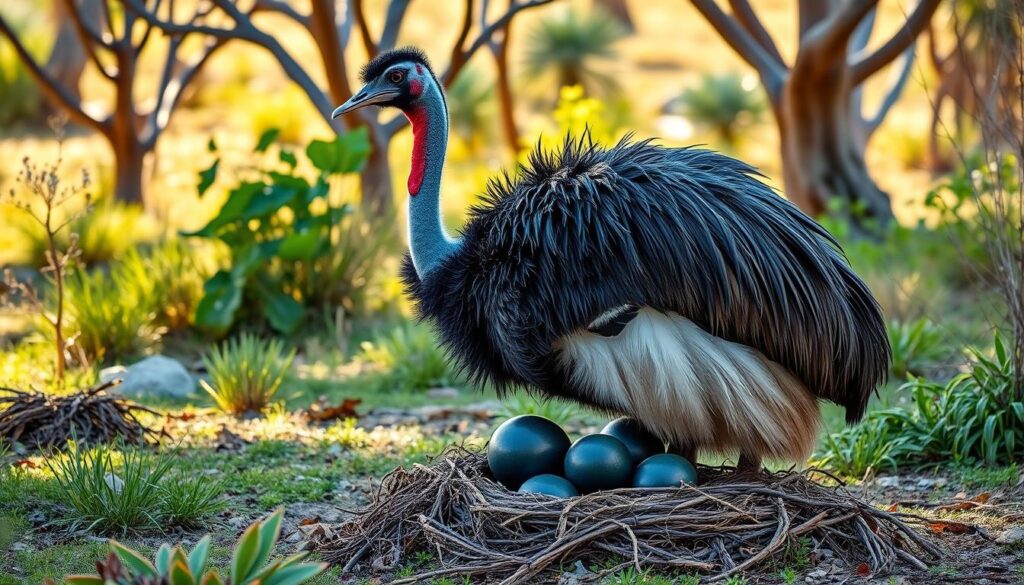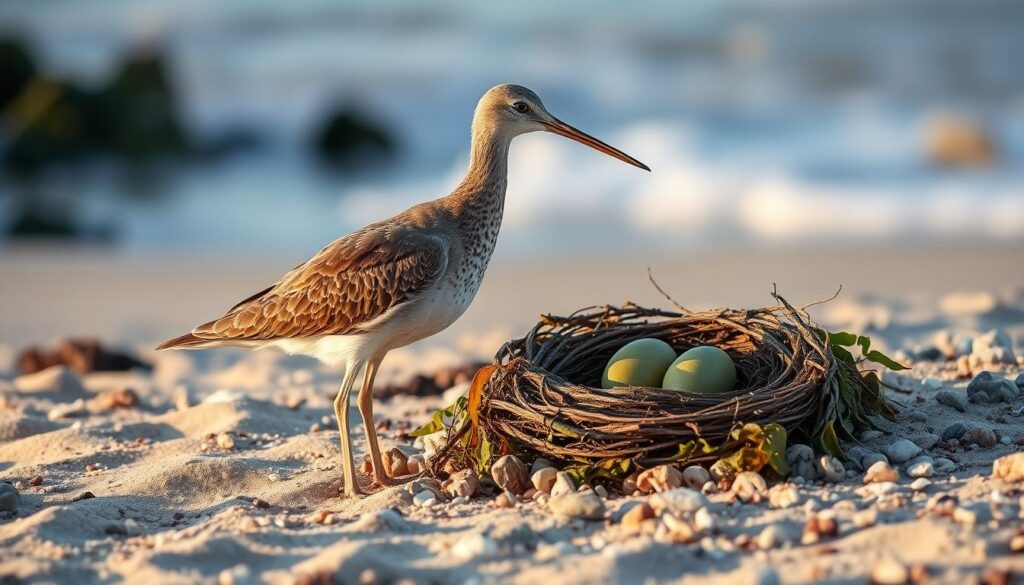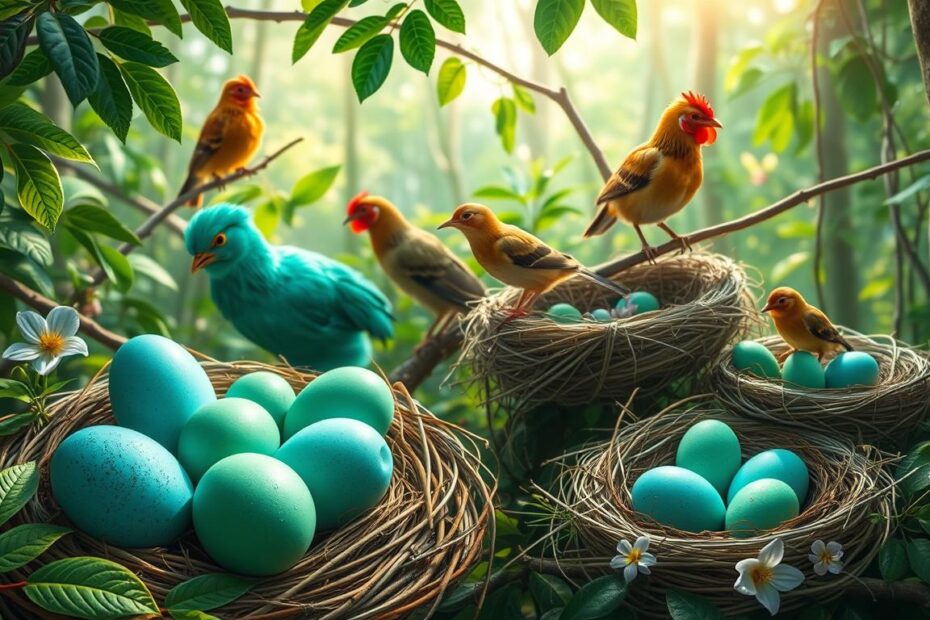I’ve always been fascinated by birds. Their egg colors are especially interesting. While most eggs are white or speckled, some birds lay green eggs. These green eggs are not just beautiful; they also help protect the baby birds inside.
Key Takeaways
- Several bird species around the world lay green eggs, ranging from small to large species.
- The distinct green color of the eggs is caused by a pigment called biliverdin, which is derived from the breakdown of red blood cells.
- The green coloration serves as camouflage, protecting the eggs from predators.
- The article will explore the fascinating world of birds that lay green eggs, including their species, habitats, diets, and the significance of this unique egg coloration.
- Understanding the reasons behind this unique adaptation will provide insights into the remarkable evolution and adaptation of these birds.
Exploring the Avian Wonders of Green Egg-Laying Birds
Introduction to the Unique Coloration of Bird Eggs
The world of birds is full of amazing colors, shapes, and sizes. This variety shows how birds have adapted over time. Green eggs are especially fascinating to bird lovers and nature fans.
The color of a bird’s egg comes from pigments in the shell. Biliverdin, a green pigment, is key. It comes from broken-down red blood cells. A bird’s diet also affects its egg color.
These pigments mix with the environment to create different shades. For example, the Elegant Crested Tinamou has deep green eggs. The Southern Cassowary’s eggs are a light green. Each egg color is shaped by evolution to help birds survive and reproduce.
“Bird eggs come in a wide variety of colors, shapes, and sizes, reflecting the remarkable diversity of the avian world.”
Let’s explore the green egg-laying birds further. We’ll learn about their colors and how they help them survive. From forests to the Australian outback, these birds show how adaptable and resilient they are.
Why Do Birds Lay Green Eggs?
Green eggs from some birds come from a pigment called biliverdin. This pigment forms when red blood cells break down. It gives the eggs their bright green color.
The Role of Biliverdin Pigment in Egg Coloration
Biliverdin is key in making the eggshell’s color. Birds produce it and put it on the eggshell when they lay eggs. How much biliverdin is used affects the egg’s green color.
Dietary Influences on Egg Color and Bird Health
A bird’s diet also affects egg color. What it eats can change the eggshell’s color. For example, eating foods with carotenoids, like fruits and veggies, can make eggs more colorful. This shows how diet and health are linked in green egg-laying birds.
“The green color of eggs laid by certain bird species is a testament to the intricate interplay between a bird’s physiology, its diet, and the evolutionary adaptations that have shaped its unique traits.”
Camouflage and Protection: The Adaptive Benefits of Green Eggs
The green color of some bird eggs helps them blend in. This camouflage is key for birds nesting on the ground or in green areas. It makes the eggs hard to spot by predators, helping the eggs stay safe.
Many studies have looked into how green eggs help protect birds. For example, a 2015 study showed that zebra finches with more carotenoids laid brighter red eggs. Birds in open spots might lay pink eggs to hide better.
The green coloration provides a critical layer of camouflage that boosts nesting success. Research on African tawny eagles and black sparrowhawks found that birds in riskier spots had redder eggs. This helps them blend in.
- Ground-nesting birds like plovers and nightjars often lay beige or pinkish eggs with dark splotches to match their surroundings.
- Flamingos build cone-shaped nests in large colonies with thousands of birds nesting together, further enhancing the camouflage effect.
- Females of weaver birds typically lay between 2-4 pinkish eggs in a clutch, blending in with the nesting environment.
A 10-year study of plover nests showed that predators found eggs with clear markings easier. This highlights the camouflage benefits of green egg-laying birds.
Elegant Crested Tinamou: A Terrestrial Gem with Glossy Green Eggs
In southern Chile and Argentina, a special bird lives in the shrublands. The elegant crested tinamou is known for its olive-brown feathers and a white stripe on its head. It’s famous for laying glossy green eggs, a rare sight in birds.
Habitat and Diet of the Elegant Crested Tinamou
This bird loves the dense undergrowth and scrublands of its home. It’s a ground-dwelling bird, using its senses to find food in the thick vegetation. Its diet changes with the seasons, eating plants in winter and insects in summer.
The green eggs of the elegant crested tinamou are perfect for hiding in the ground. This color helps protect the eggs from predators, keeping the bird’s family safe.
“The elegant crested tinamou’s vibrant green eggs are a true marvel of nature, showcasing the bird’s remarkable evolutionary adaptations to its terrestrial habitat.”
Southern Cassowary: The Flightless Giant with Pea-Green Eggs
The southern cassowary is a true marvel among birds. It’s a massive flightless bird found in Indonesia, Papua New Guinea, and northeastern Australia. It’s famous for its pea-green eggs.
This bird, also called the double-wattled cassowary, is huge. It can grow up to 2 meters tall and weigh 76 kilograms. It has black feathers, a blue face, red throat wattles, and a helmet-like casque on its head.
What’s most amazing about the southern cassowary is its green eggs. These eggs are about 138 by 95 millimeters. They blend in well with the rainforest where the bird lives. The male cassowary incubates 3-4 eggs for 50 days, helping the eggs hatch.
“The southern cassowary is listed as endangered at both the Queensland state and Australian government levels, with recent surveys suggesting there may be fewer than 4,600 cassowaries left in the wild.”
The southern cassowary faces many dangers. Car accidents, dog attacks, and rainforest clearing threaten its survival. Groups like Rainforest Rescue and the Southern Cassowary Captive Management Programme work to save it.
The southern cassowary is an incredible bird. Its green eggs and large size show the beauty of nature. By protecting this bird and its home, we help future generations see its importance in the rainforest.
Emu: Australia’s Iconic Flightless Bird with Dark Green Eggs
The emu is a fascinating bird from Australia, famous for its large size and dark green eggs. It is the second-largest bird alive. Emus can grow up to 6.6 feet tall and weigh between 80 to 150 pounds.
Emu Egg Size and Incubation Period
Female emus lay big, dark-green eggs that are 9 by 13 centimeters and weigh about 2 pounds. The male emu incubates these eggs for about 8 weeks. After that, the young emus grow to full size in just six months.
Habitat and Diet of the Emu
Emus live in many places in Australia, like open plains and forests. They are good at hiding and can live in different environments. Their dark green eggs blend well with their surroundings.
Emus eat a variety of foods, including plants, insects, small mammals, and lizards. They are also very fast, running up to 30 miles per hour. Emus are a wonder of nature and a symbol of Australia.

“The emu is a truly remarkable bird, with its striking appearance and unique adaptations to the Australian landscape.”
What Birds Lay Green Eggs
Many birds lay green eggs, not just the elegant crested tinamou, southern cassowary, and emu. The Eurasian whimbrel, a wading bird, lays olive-green eggs. The Araucana chicken, from Chile, lays blue or green eggs. These birds show the amazing diversity in the avian world.
Araucana chickens lay about 250 eggs a year. Their green eggs are as nutritious as white or brown eggs. Olive Eggers, a mix of chickens, lay olive-colored eggs. Easter Eggers, another mix, lay eggs in shades like blue and green.
| Breed | Egg Color | Eggs per Year |
|---|---|---|
| Araucana | Blue, Green | 250 |
| Olive Egger | Olive | 200-280 |
| Easter Egger | Blue, Green | 250-300 |
| Isbar | Light Green | 150-200 |
| Green Queen | Green | 250-275 |
Chicken breeds offer a variety of egg colors for your backyard. Whether you want the emu’s deep green or the Araucana’s blue-green, there’s a bird for you. They add beauty and nutrition to your life.
Eurasian Whimbrel: A Wader with Olive-Green Eggs
The Eurasian whimbrel is a unique wading bird known for its olive-green eggs with brown spots. These eggs are laid in a bare spot on the tundra or Arctic moorland. They blend in well with their surroundings, hiding from predators.
Nesting Behavior and Egg Coloration of the Eurasian Whimbrel
The Eurasian whimbrel migrates to coastal areas in Africa, South Asia, and Australasia for the winter. During breeding, both parents fiercely guard their nesting area. They protect their eggs and chicks from threats.
The eggs’ olive-green color helps in this defense. It blends well with the tundra. The color comes from biliverdin, a green pigment in the eggshells. This pigment is linked to the bird’s diet.

Studying the Eurasian whimbrel’s nesting and egg coloration shows its amazing adaptations. These help its young survive in the harsh Arctic.
Araucana Chicken: The Breed with Blue and Green Egg-Laying Prowess
The Araucana chicken is special for laying blue and green eggs. It comes from Chile and is loved by backyard chicken keepers and small farmers. Its looks and egg-laying skills make it a standout.
Breed Characteristics and Egg Production of the Araucana Chicken
The Araucana chicken has a pea comb and might not have a tail. These traits make it look unique. They are also known for laying a lot of eggs, about 250 a year.
The blue and green eggs of Araucana chickens are not just pretty. They show the breed’s special genetics. This makes the Araucana a standout in the world of araucana chicken, chicken breeds that lay green eggs, and blue and green eggs.
| Breed | Egg Color | Eggs per Year | Temperament |
|---|---|---|---|
| Araucana | Blue, Green | 250 | Friendly, Active |
| Ameraucana | Blue, Green | 200 | Calm, Docile |
| Easter Egger | Blue, Green, Pink, Cream | 280 | Curious, Sociable |
| Marans | Dark Chocolate Brown | 180 | Friendly, Timid |
The Araucana’s fame shows how much people love unique chickens. Exploring araucana chicken, chicken breeds that lay green eggs, and blue and green eggs reveals the beauty of poultry diversity. Each breed adds its own special touch to the world of chickens.
The Global Distribution of Green Egg-Laying Birds
Green eggs are not just found in one place. They can be seen all over the world. This shows how diverse our bird friends are. From the elegant crested tinamou in southern Chile and Argentina to the southern cassowary in Indonesia, Papua New Guinea, and Australia, green egg-laying birds are everywhere.
The emu, found only in Australia, lays dark green eggs. The Eurasian whimbrel, a wading bird, migrates through Africa, South Asia, and Australasia. Its olive-green eggs match its many habitats.
The Araucana chicken, from Chile, is now loved worldwide. It’s famous for laying blue and green eggs. This has made it a favorite among bird lovers and chicken fans.
These green egg-laying birds show how adaptable and strong they are. Each one thrives in its own special place. They add to the beauty and variety of our planet.
| Species | Geographic Range | Egg Color |
|---|---|---|
| Elegant Crested Tinamou | Southern Chile and Argentina | Glossy green |
| Southern Cassowary | Indonesia, Papua New Guinea, Northeastern Australia | Pea-green |
| Emu | Australia | Dark green |
| Eurasian Whimbrel | Africa, South Asia, Australasia | Olive-green |
| Araucana Chicken | Worldwide (originated in Chile) | Blue and green |
These green egg-laying birds show how adaptable and strong they are. They live in many places, from South America to Australia. Each one adds to the beauty and variety of our planet.
Conclusion
The world of birds is truly remarkable, with a wide range of species laying stunning green eggs. From the glossy green eggs of the elegant crested tinamou to the pea-green hues of the southern cassowary, these eggs serve important purposes. They help with camouflage and protect against predators.
The vibrant green shades come from biliverdin pigment and what these birds eat. This makes their eggs stand out in the natural world.
Exploring the fascinating birds that lay green eggs sparks wonder and shows the natural world’s diversity and resilience. The summary of green egg-laying birds and the importance of green egg coloration highlight their unique adaptations. This journey through the avian realm has shown us the beauty, complexity, and ecological significance of these feathered architects.
As we continue to uncover the mysteries and wonders of the avian kingdom, our appreciation for birds will grow. The study of green egg-laying birds shows the incredible adaptations and evolutionary triumphs that have shaped our planet. By understanding and preserving these avian marvels, we can ensure their enduring presence and the vitality of the ecosystems they inhabit.
